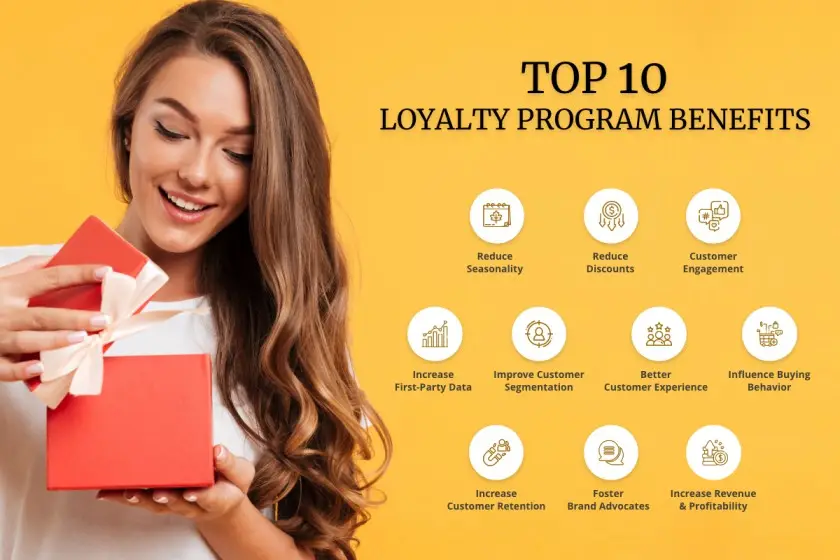There are numerous loyalty program benefits on which companies base their business strategies. If you have not implemented a loyalty rewards program, check out the top 10 benefits of customer loyalty programs listed below. This blog can help you justify and set objectives for your company’s loyalty program. It will also assist you in maximizing the benefits of having a loyalty program.
Top 10 Benefits of Customer Loyalty Programs
1) Reduce Seasonality
Brands may face a slow sales season depending on the industry they operate in. A loyalty program can boost business during these slower seasons by giving customers a reason to shop. Companies may decide to give out additional loyalty points during slow seasons. Setting an expiration date for these additional points will encourage customers to purchase within a certain timeframe. Yonka Paris implemented a similar strategy and witnessed a 2.26X increase in sales. The way Yonka Paris executed their strategy, they were able to increase customer engagement too.
2) Reduce Discounts
Discounts are one of the easiest ways to attract new customers. But discounts decrease the profit margins and do not guarantee repeat purchase from such customers. On the other hand, awarding loyalty points increase the probability of the customer making the next purchase. Thus, loyalty points create a hook for two purchases, the current purchase and the following purchase. Moreover, points come at fraction of the cost of discount vouchers because they can be exchanged for items that have high perceived value and low cost.
3) Customer Engagement
Customers will not purchase from you every day. Depending on the value of the product the frequency of purchases will vary. This hibernation period should be utilized to stay on top of their minds. To achieve this, you need to keep them engaged with your brand. So, the next time the customer is ready to make a purchase, your company should be the go-to brand. The best loyalty programs provide a 360-degree loyalty engagement engine that allows customers to earn loyalty points for a variety of activities. Loyalty points that are earned can be redeemed for various rewards. These rewards and points will ensure the customers stay invested in your brand. Customers engaged in a brand’s loyalty program will spend 12-18% more each year.
4) Increase First-party Data
Loyalty programs ethically generate a lot of customer data when customers create their profiles. Their purchase history and preferences can also be studied over time. This is critical with stringent data privacy laws and the ban on third-party cookies. Loyalty programs can run incentivized surveys to learn more about the customers who are willing to share. Customers get a chance to voice their expectations and get bonus points in return. A win-win situation. By tracking all the sources of information, loyalty programs gain insights into buying behavior. With such insights, businesses can realign their marketing strategies.
5) Improve Customer Segmentation
A business can learn a lot about the shopping habits of customers. Within the loyalty program, machine learning techniques can finely segment customers based on the type of products purchased, the value of purchases, frequency, trends, seasonality, social behavior, survey responses, etc. Such user segments could be high spending customers people who engage with the brand on social media platforms, or people interested in certain service offerings. Based on these user segments, the loyalty program can send communication for specific products and offers to such customers. Machine learning can further segment these customers based on how they interact with such communication. This makes it possible to further personalize the customer experience. Thus, machine learning in loyalty programs can be used to track customer behavior and use this tracking to engage & retain such customers using personalized campaigns. 82% of customers feel more positive about a brand after engaging with personalized content. This significantly improves the efficiency of your marketing dollars.
6) Better Customer Experience
84% of companies that work to improve their customer experience report an increase in their revenue. With better customer segmentation, brands can tailor the communication sent to each user segment. The customers look forward to communication from your side when it is relevant for them. The more personalized attention you give your customers, the stronger the emotional bond they form with the brand. Emotions are the key to building relationships with potential customers, and these relationships are more resistant to changes in the market, competitors’ advertising, and pricing changes. Start thinking about your customers’ emotions, find ways to connect with them in an authentic way, and you’ll see the results quickly.
7) Influence Buying Behavior
A customer’s buying behavior is influenced by convenience, price, the overall experience and the value they derive out of the transaction. Depending on the scenario, brands can influence the buying behavior to increase the customer’s purchase frequency, the AOV or to reduce the brand’s expenses. One such example is of Yonka Paris. Processing the monthly credit card fee was turning out to be a big expense. Yonka Paris wanted their customers to pay through direct bank transfers and reduce the credit card fees. All they had to do was initiate a campaign which offered free shipping along with additional bonus loyalty points if customers transferred money directly to the bank. With this simple strategy they were able to reduce their expenses considerably.
8) Increase Customer Retention
Your chances of selling to a new customer are just between 5% and 20%, whereas that chance rises to 60% or 70% for existing customers. Without a customer reward program, the only way to incentivize the next purchase is discounts. This will hurt your margins as well as your end goal of creating true brand loyalty. The primary benefit of a loyalty program is it allows brands to nurture customers. By engendering brand loyalty, the brands witness higher AOV, increased purchase frequency, and higher customer lifetime value.
9) Foster Brand Advocates and Increase User-generated Content
A loyal customer is a vocal customer. A brand must reward customers for ‘User Generated Content’ (UGC) like reviews, testimonials, referrals, customer photos, etc. with loyalty points. An analysis will give you a good idea of how much each piece of UGC is worth. E.g., just three reviews can typically increase your product conversion rate by up to 2%. As a rule of thumb, a good review could increase your AOV by 2.5%. Once you have a good estimate of how much a UGC is worth, you can then calculate the maximum number of points you can award for that piece of content. And it doesn’t end here. Brand advocates positively influence their network and help with brand penetration. Over 70% of consumers are more likely to recommend a brand if it has a good loyalty program. A referral program can further help in creating brand advocates and bring in more referrals which aid customer acquisition.
10) Increase Revenue and Profitability
Harvard Business Review estimates that a mere 5% increase in customer retention correlates with at least a 25% increase in profit. This is the most important loyalty program benefit. The success of a loyalty program is measured by its ability to increase the repeat purchase revenue. Furthermore, A brand can reduce their customer acquisition costs through referrals and improve the ROI of targeted marketing campaigns.
This article describes the benefits of having a loyalty program. Use it to do a cost vs. benefit analysis of a loyalty program. You can also use Zinrelo Value Calculator to estimate the ROI that you can get from a loyalty program.

What determines the success of a rewards program is the loyalty platform that enables it. Zinrelo offers the best loyalty software to help your brand in customer retention. Hundreds of brands are benefiting from Zinrelo’s robust, secure, and scalable loyalty platform. What makes Zinrelo stand out from the other platforms is the specialized data analytics approach and strategic consultation offered along with the technology to enable loyalty offers and promotions relevant to customers.


